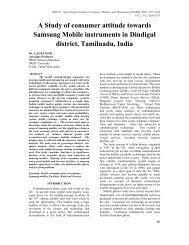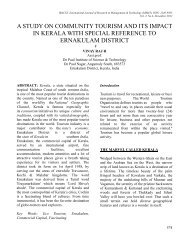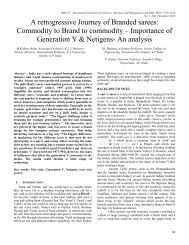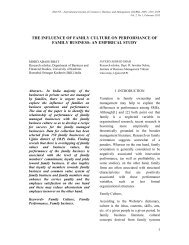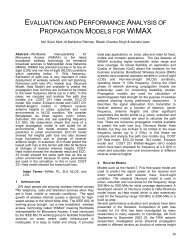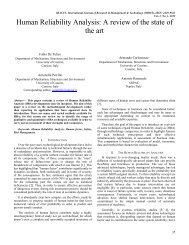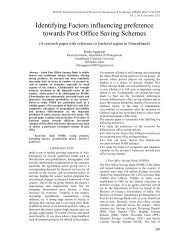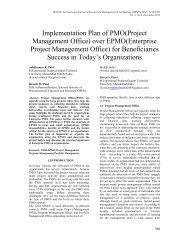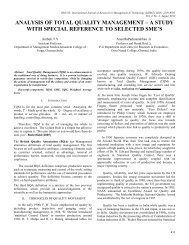IRACST- International Journal <strong>of</strong> Research in Management & Technology (IJRMT), ISSN: 2249-9563Vol. 3, No.3,June 2013ANOVA bModelSum <strong>of</strong>SquaresDFMeanSquareFSig.1Regression5.414E8 6 9.024E798.717.000 aResidual 5.073E8 555 914135.225Total 1.049E9 561a. Predictors: (Constant), p/eratio, bv, dc, dy, dps, epsb. Dependent Variable: mpSource: Author’s self‐calculationthe overall fitness <strong>of</strong> the model indicates that themodel is capable <strong>of</strong> explaining about 51.6% <strong>of</strong> thevariability in the share prices <strong>of</strong> firms. This meansthat the model explains about 51.6 % <strong>of</strong> thesystematic variation in the dependent variable. Thatis, about 48.4% <strong>of</strong> the variations in movement <strong>of</strong>stock prices <strong>of</strong> the sampled firms are accounted forby other factors not captured by the model.Thisresult is complimented by the adjusted R 2 <strong>of</strong> about51.1%, which in essence is the proportion <strong>of</strong> totalvariance that is explained by the model.Analyzing further empirical findings listed in tableVI depict that there is a significant positiverelationship between firms’ book value and themarket value <strong>of</strong> share prices <strong>of</strong> the listed firms in<strong>NSE</strong> <strong>100</strong>. This is evident in the t-statistics value <strong>of</strong>0.000 and p-value>|t| (95% confidence level) Thisoutcome basically implies that with all othervariable held constant, an increase or a change inthe book value <strong>of</strong> the firms, say by one percent willon the average bring about a 1.649% percentincrease in the market price <strong>of</strong> shares. That is anincrease in the book value <strong>of</strong> firms will also lead toa positive improvement in the share prices <strong>of</strong> listedfirms. Noticeably, the results <strong>of</strong> the present study isin line with the propositions <strong>of</strong> Zahir & Khanna(1981) Balkrishan (1984), Singhania (2006) andAL-Omar and AL-Mutairi (2008) where the resultsindicated that book value significantly influencedthe market value <strong>of</strong> share prices. Similarly, furtherempirical findings enlisted in table VII also showthat there is a significant positive relationshipbetween firms’ earning per share and the marketvalue <strong>of</strong> share prices. This is evident in the t-statistics value <strong>of</strong> 16.701 and the p-value>|t|. Theresults can be explained as that an increase inearning per share will invariably bring about asignificant increase in the market prices <strong>of</strong> equityshares. Importantly this outcome is consistent withefindings provided in Midani (1991), AL-Omar andAL-Mutairi (2008), Somoye et al(2009),Uddin(2009) where it has been observed that earning pershare is a major determinant <strong>of</strong> stock prices. Thenext significant factor that emerges out <strong>of</strong> theempirical findings is dividend yield which has aninverse relationship with that <strong>of</strong> market price. Thisresult basically means that with the influence <strong>of</strong>other variable held constant, as firms dividend yield93
changes; say by one percent, on average, marketprice <strong>of</strong> share changes by 6.607 percent in theopposite direction. These results are supported withthe findings <strong>of</strong> Zahir & Khanna (1981),Zahir(1992),Irfan & Nishat (2002).Finally theregression analysis brings out a significantrelationship between price earnings ratio and marketprice. This is evident <strong>from</strong> the t-statistics value <strong>of</strong>(9.617 and p-value >|t| at 95% confidence level.These results corroborate with those <strong>of</strong> Mehta &Turan (2005) and Singhania (2006).The remainingfactors namely dividend per share and dividendcover are the insignificant factors as per the analysisnot having much <strong>of</strong> an impact on the market price<strong>of</strong> stocks.Referring to table VII, it can be noted <strong>from</strong> theFishers ratio (i.e. the F-Statistics which is a pro<strong>of</strong> <strong>of</strong>the validity <strong>of</strong> the estimated model) that the p-valuethat is less than 0.05 (p-value < 0.05); this hasinvariably clear implications that the explanatoryvariable are significantly associated with thedependent variable. That is, they strongly determinethe behavior <strong>of</strong> the market movement <strong>of</strong> stockprices.VII.IRACST- International Journal <strong>of</strong> Research in Management & Technology (IJRMT), ISSN: 2249-9563Vol. 3, No.3,June 2013CONCLUSIONThis study primarily examined the effects <strong>of</strong> bookvalue, earning per share, dividend per share,dividend yield, dividend cover and price earningsratio on <strong>from</strong> the study the share price <strong>of</strong> firmslisted on <strong>NSE</strong> <strong>100</strong>. The findings <strong>of</strong> the study for theperiod 2007-12 revealed that firms’ book value,earning per share and price-earnings ratio arehaving a significant positive association with firm’sstock price while dividend yield is having asignificant inverse association with the market price<strong>of</strong> the firm’s stock. Together these four variablesexplain 51.6% <strong>of</strong> the dependent variable. Theresults indicated above are in close conformity withthe findings <strong>of</strong> the previous studies- Zahir (1992),Singhania (2006), Somoye et al (2009).Theremaining variables namely dividend cover anddividend per share are not significantly impactingmovement f stock prices listed on <strong>NSE</strong> <strong>100</strong>.Thefindings <strong>of</strong> the present study are particularly usefulfor investors and fund managers as they can watchout for these significant factors while analyzingstock returns and predicting future prices.As nearly 48.4% <strong>of</strong> the movement in stock pricesremains unexplained thus there is scope for furtherresearch in this area as there are factors not includedin the study which can precisely explain theremaining unexplained movement <strong>of</strong> stock prices.REFERENCES[1] Al-Omar, H. and Al-Mutairi, A. 2008, TheRelationship between the Kuwaiti Banks Share<strong>Prices</strong> and Their Attributes. Scientific Journal <strong>of</strong>King Faisal University (Humanities andManagement Sciences), 9(1): 325-338.[2] Balkrishnan(1984), "<strong>Determinants</strong> <strong>of</strong> Equity<strong>Prices</strong> in India", Management Accountant, Vol. 19,No. 12 (Dec), p. 728-730[3] Chawla, D. and Srinivasan, G. 1987., Impact <strong>of</strong>Dividend and Retention on Share Price – AnEconometric Study. Decision, 14(3): 137-140.[4] J. 1957, How to Study the Behavior <strong>of</strong> Bank<strong>Stock</strong>s. The Analysts Journal, 13(2): 109-113.[5] Irfan, C. M. and Nishat, M. 2002, KeyFundamental Factors and Long-run Price Changesin an Emerging Market - A Case Study <strong>of</strong> Karachi<strong>Stock</strong> Exchange (KSE). The Pakistan DevelopmentReview, 41(4): 517–533.[6] Karathanassis, G. and Philippas, N,1988,Estimation <strong>of</strong> bank stock price parameters andthe variance components model, AppliedEconomics, 20(4): 497-507.[7] Khan,S. H. 2009. <strong>Determinants</strong> <strong>of</strong> Share PriceMovements in Bangladesh: Dividends and RetainedEarnings. Retrieved April 29, 2010 <strong>from</strong>http://btu.se/fou/cuppsats.nsf/all/7a3a58f2c2af8ba1c1257695000a3b1d/$file/Final%20Version.pdf.[8] Mehta, S. K. and Turan, M. S. 2005.<strong>Determinants</strong> <strong>of</strong> <strong>Stock</strong> <strong>Prices</strong> in India: An <strong>Empirical</strong>94



